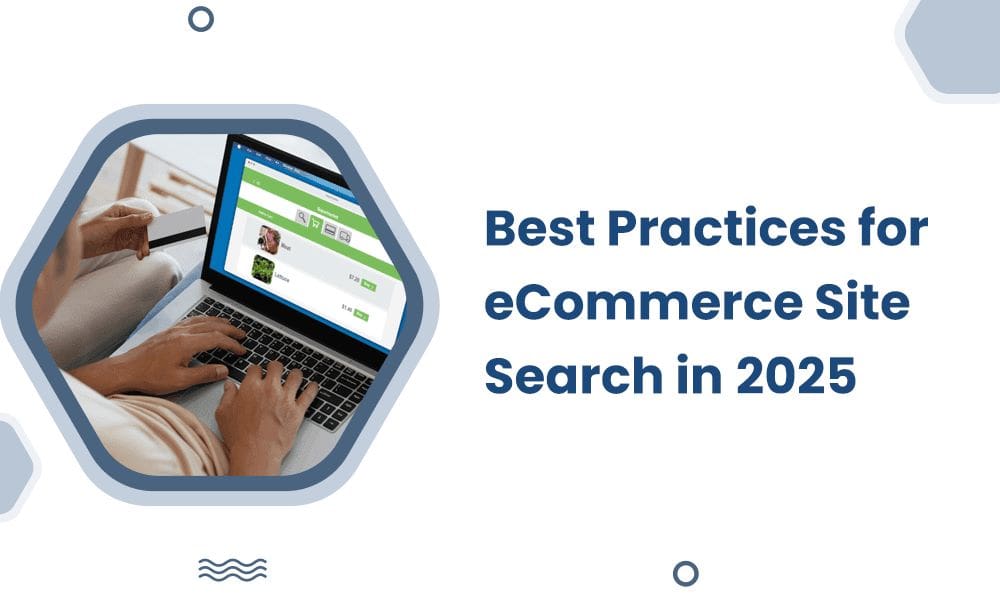Do you want to bring your eCommerce shoppers’ attention to their desired items? eCommerce site search can be a powerful feature that can make your business grow and scale within no time.
It is one of the most important functions of an eCommerce site, yet it is the most overlooked. Do you know what a site search is? Well, it is a search engine solution that can be integrated into your eCommerce store.
Effective site search makes it easy to collect data points on what your customers want, how they talk about your products, and how you can optimize your offer just for them.
eCommerce site search enhances the search experience for your customers, which further helps you attract more leads, increase conversions, and reduce bounce rates in the long run.
In this blog post, we’ll explore the best practices for eCommerce site search, key components of a site search, and common pitfalls to avoid.
Let’s dive in.
Table of Contents
Key Takeaways
- Analyze search data to gain insights into which products are high in demand, and optimize inventory management.
- Design a user-friendly eCommerce site by integrating site search capabilities. It will allow your customers to find the information they need and increase user interactions and sales.
- Enhance your site search with autosuggestions and autocomplete, search filters and faceted search, and keyword optimization.
- Keep up with your industry trends by integrating your eCommerce site with voice search capabilities.
- Optimize your websites for mobile to target a broader audience, as mobile-friendly sites show up higher in the search engines and help you get the most of the traffic.
- Monitor and evaluate your website traffic, click-through, bounce, engagement, and conversion rates to optimize your strategies and improve your online presence.
Understanding eCommerce Site Search
eCommerce site search is an internal search engine that provides the most relevant data related to the products, information pages, or a shopper’s query.
It is used on-site to sync customer search queries with descriptions, images, videos, product titles, reordering codes, etc. The internal search engine then relates these search terms with the products and pages labeled in your eCommerce back end to offer personalized recommendations to visitors on demand and at scale.
The better configured the site search engine, the easier it will be for customers to find the information they seek. This is like the self-service trend, wherein customers won’t require any support team or assistance as they can seamlessly search and shop for products they like on your eCommerce site.
Using a site search engine allows website visitors to query your database and get answers to their questions about your company or products.
It has become imperative today because site search data gives businesses insights into what customers need and prefer and which products are most searched for. Therefore, boosting your site search capabilities will likely give you an edge and capture a broader market share.
The best eCommerce search engine is the one that can answer all visitors’ queries, provide suggestions, and guide shoppers further along the path to a satisfying purchase.
Read also: eCommerce Email Copy — 12 Tricks to Drive More Conversions
Key Components of Effective eCommerce Site Search
A good site search speeds up the journey of your visitors. But what elements make a site search powerful? This section will help you learn about the key components that will enhance your user’s site search experience.
1. Autocomplete and autosuggestions
Put yourself in your buyer’s shoes. Sometimes, you don’t know what to type in to get the required product. Well, that’s normal. This is where the autocomplete and auto-suggestions features come into play. Providing these features helps increase user engagement and enhance the overall search experience.
With autosuggestions, you can empower your eCommerce site by letting it sensibly predict what users want as they begin typing their search query. Then, your users will see an alphabetical list of relevant options, which speeds up the search process and helps customers formulate their queries quickly.
Let’s understand how it works: when a customer types in their query, the predictive search algorithm lists the suggested search terms. The major benefit of these features is not limited to speeding up the search process but also refining your customers’ overall product discovery experience.
2. Search filters and faceted search
Providing filters and facets is important as it brings further specificity to customers’ searches. Filters and sorting functions help them easily make choices, as they can narrow down the results by choosing attributes such as color, size, price, pattern, size, seller, brand, etc.
This reduces the confusion of choosing from many products and allows users to search for desired results, such as price range, top-rated/trendy, etc.
This feature is primarily useful for websites with extensive databases, as it helps users find the most relevant option.

3. Keyword optimization
Effective keyword research is essential to improve your website’s ranking. Keywords are the foundation of every eCommerce SEO campaign. So, you need to start by searching for the high-volume search terms with more click-through rates that your potential customers are using. You can use any free or paid keyword research tool.
Searching for eCommerce keywords is relatively different from finding traditional keywords for websites or blogs. You need to find the best keywords, as the list of your keywords also influences your technical SEO. Remember that keyword research should be done with product-focused keywords in mind.
Also, it is recommended to use long-tail keywords, as they cater to specific audiences and tend to convert better than short-tail keywords. For example, instead of ‘party dresses,’ it is better to use the keyword ‘party dresses for slim ladies.’
Read also: 19 eCommerce Best Practices to Win Customer Confidence in 2025
Advanced Features for eCommerce Site Search Optimization
Here are three advanced features for site search optimization.
1. Natural Language Processing (NLP)
One of the most important aspects of excellent site search optimization is targeting the right audience by understanding your users’ intent. Once you can identify the intent behind specific queries and keywords, you can structure your content accordingly.
Natural Language Processing focuses on generating data on everything from user intent to popular terms and phrases. NLP helps understand your users’ intent by analyzing complex queries better than keyword-based searches. Moreover, its data is used to improve SEO and inform content strategies.
2. Machine learning
Do you want to enhance your search results? An effective site search lets you delve deeper into search marketing and anticipate your users’ behavior, which helps improve your search relevance. You can easily ensure this by analyzing patterns from historical data trends.
3. Voice search integration
Understanding the shift in consumer behavior is vital. Based on this analysis, you can segment your customers and engage customers who prefer voice shopping. Enabling voice search capabilities on your eCommerce site will empower your customers to state what they want.
So, how does it work? All they need to do is speak what they want to search, and their voice input is then transcribed to text and handled like a regular search.
Integrating voice search optimization into your eCommerce site can make the overall experience convenient, accessible, and satisfying for your customers.
Read also: 17 Fresh eCommerce Marketing Ideas to Dominate Your Niche!
Best Practices for eCommerce Site Search
We have collected some on-site search best practices to improve your eCommerce site search. Let’s take a look.
1. Prioritizing relevant results
How about personalizing the search results for your customers?
One of the best ways to do this is by prioritizing search fields and setting up filters after identifying the target audience’s behavior. It will improve your search relevance. Moreover, displaying the most relevant products can increase the likelihood of conversion.
2. Mobile optimization
Designing a well-optimized mobile-friendly site is the key to delivering a smooth user experience and increasing customer satisfaction. A survey found that more than 96% of global customers access the internet via mobile phones. Thus, targeting a broader audience by developing a mobile-optimized eCommerce site is important.
Some of the best ways to develop mobile-friendly eCommerce sites include using a responsive theme, providing comfortable navigation, reducing unnecessary scrolling, prioritizing speed, and being careful about pop-ups.
3. Performance metrics
Monitoring website performance metrics ensures a seamless and responsive online presence. These indicators surpass various aspects, including click-through rates, user interactions, conversion rates, bounce rates, and overall website responsiveness.
These metrics help you track the growth and performance of your eCommerce website, identify areas for improvement, and gauge future inventory needs.
Read also: 5 eCommerce Email Marketing Software to Help You Sell More
Common Pitfalls in eCommerce Site Search
Site search is one way consumers navigate vast product catalogs, seeking the perfect product to meet their needs on eCommerce sites.
Customers nowadays desire a unique, personalized experience. However, if you genuinely solve the customer’s problem, you’ll have a chance to grow your business substantially.
To elevate your business game to the next level, you must know about some common pitfalls in eCommerce search and avoid them all.
1. Poor indexing
Proper indexing allows you to maintain the uniqueness of records in a database. Every time a new record is added, it is done in a way to ensure that there are no duplicates. If you have unique records, it tremendously improves the search time.
On the contrary, poor indexing does not provide easier data manipulation. Rather than speeding up queries, an index created on various columns slows them down.
Remember, indexing plays a crucial role in the SQL Server. It has to go through numerous records to get the data requested by a query, which will use more hardware resources and shorten the data fetching process.
2. Slow search result
There can be various reasons for slow search results on your eCommerce website, and it is important to fix them to get more sales. Here are the common causes that you should keep a check on-
- Reduce HTTP requests
- Keep your content management system (CMS) up to date
- Minimize website plugins and webpage elements
- Third parties impede page rendering
- Get a reliable hosting service
- Use a content delivery network (CDN)
- Optimize website images
- Practice caching techniques
These techniques can help improve your website’s overall performance, enhance engagement, reduce bounce rates, and convert visitors into paying customers.
3. Lack of synonyms handling
This can be a major issue that can lead to a high bounce rate. Lack of synonym handling means the search engine will not provide the relevant results if a search query comprises a synonym not mapped in the database.
For example, if the customer wants to find “kids’ toys,” the search engine only returns results for “children’s toys” and not “kids’ toys.” The customer will become frustrated as he knows what to buy but can still not find it.
For sure, the customer would return without making the purchase. This is where synonyms – words with the same or similar meaning – become important in search engines.
Handling synonyms is essential, as even people who use the same language might use numerous terms for the same thing. Therefore, it is recommended to use advanced search engines that can even handle multi-language searches.
Read also: 25+ Top eCommerce Marketing Tools Sure to Boost Sales in 2025
Case Studies and Examples
Let’s take a look at the success stories of some well-known brands and how they increased website traffic by optimizing site searches.
1. Sephora
Who does not know about this cosmetic brand? It has become successful worldwide. But what is the reason for its huge success, and how did it achieve it? Along with eCommerce site search, various things made things easier for them.
This brand ensured that the products were accurately named and tagged to configure the back end of their website to display accurate results. They also simplified the user experience by providing a clear and prominent search box.
Another strategy they used was using the autocomplete feature to suggest the most common and popular search terms and products. For example, if they even type lips in the search box, they will receive suggestions, such as lip balm, lipstick, lip gloss, etc.
This company also started its campaign #SephoraSquad, wherein instead of reaching out to active influencers, it created its brand ambassadors. Sephora contacted its customers through different platforms and offered free products, professional coaching, and other incentives to promote its merchandise.
All these factors together helped Sephora gain a huge online market. In May 2024, sephora.com had revenue of $58,485,302 and a median income of $80,017.
2. Bloom & Wild
It is an online florist company operating in the UK, Austria, France, Germany, and Ireland. In the last few years, it has achieved impressive growth by customizing content for every social media channel and using site searches.
The company used different strategies to increase its brand loyalty and customer base, such as natural language processing to understand user intent, faceted search to allow users to filter results, and adding rich merchandising capabilities to site search solutions.
Prioritizing search results based on relevance and popularity helped this brand convert leads into sales swiftly. Implementing these techniques enabled them to increase their turnover by £145 million in 2021-22.
Read also: How To Build an eCommerce Website — A Complete Guide
Conclusion
Today’s customers are well-informed, fast-moving, and impatient. Moreover, in the fierce world of eCommerce, where more brands appear to offer similar products or services, there is a constant rivalry, which is making the market overcrowded.
Thus, to stay ahead of your competitors, your primary job is to remove all the barriers that could hinder your customers from discovering it. Incorporating all these eCommerce site search practices will encourage your audiences to use the search tool and make their product discovery journey seamless.
If you are looking for a tool to engage with your prospects, nurture relationships with them, and close more deals, EngageBay is the platform.
With EngageBay, you can convert casual browsers into active shoppers and improve your product’s search functionality. It is the best tool to save time and resources you spend on managing and controlling repetitive tasks.
So, if you are looking to attract more visitors, achieve greater customer retention, and boost overall brand loyalty, EngageBay can be your go-to tool.
Sign up for free with EngageBay or book a demo with our experts.
FAQ
What are the best tools for eCommerce site search optimization?
The best tools to grow your online store include Ahrefs, Moz, Semrush, Ubersuggest, Screaming Frog, and Google Analytics.
How does site search affect conversion rates in eCommerce?
Site search enables customers to easily and quickly find the products or services they seek. This helps drive more clicks and boost conversions.
What are some common user frustrations with eCommerce search functions?
Some of the weaknesses of eCommerce search functions include:
- Only relying on keyword-based search functionality leads to inaccurate search results
- Substandard browsing and navigation experience
- Downplaying the importance of product recommendations
- Downplaying the importance of product recommendations
How can small eCommerce sites improve their search features on a limited budget?
Here are some of the best practices to ensure a fully optimized site search for your small eCommerce site even when you are low on budget:
- Make the search box visible
- Provide synonym results
- Support autocorrect functionality
- Never allow a site search to end with nothing
- Configure mobile search functions
What future trends in eCommerce site search should business owners be aware of?
One major thing you should pay attention to today is optimizing your site for voice search. Another important thing to ensure is the responsiveness of your eCommerce site on mobile.
Focusing on AI and Machine Learning enhancements is also essential for your eCommerce site, as they help transform how site searches interpret and respond to user queries.

